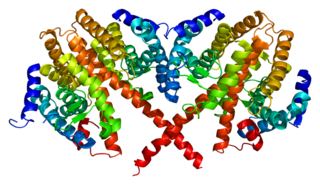Factor nuclear 4 alfa de hepatocito
El factor nuclear 4 alfa de hepatocito (HNF4A) también conocido como NR2A1 (de sus siglas en inglés "nuclear receptor subfamily 2, group A, member 1") es un receptor nuclear codificado en humanos por el gen HGNC HNF4A .[1][2]
| Factor nuclear 4 alfa de hepatocito | ||||
|---|---|---|---|---|
 Estructura tridimensional de la proteína HNF4A. | ||||
| Estructuras disponibles | ||||
| PDB |
Lista de códigos PDB 1m7w
| |||
| Identificadores | ||||
| Símbolos | HNF4A (HGNC: 5024) FLJ39654, HNF4, HNF4a7, HNF4a8, HNF4a9, MODY, MODY1, NR2A1, NR2A21, TCF, TCF14 | |||
| Identificadores externos | ||||
| Locus | Cr. 20 q13.12 | |||
| Ortólogos | ||||
| Especies |
| |||
| Entrez |
| |||
| UniProt |
| |||
| RefSeq (ARNm) |
| |||
Función
editarLa proteína HNF4A es un factor de transcripción que une ADN en forma de homodímero y controla la expresión de diversos genes, incluyendo la del factor nuclear 1 alfa de hepatocito, un factor de transcripción que regula la expresión de varios genes hepáticos. Esta proteína juega un importante papel en el desarrollo del hígado, del riñón y de los intestinos. se han asociado mutaciones en este gen con la enfermedad monogénica autosómica dominante diabetes mellitus tipo MODY (MODY 1). Se han descrito diversos transcritos alternativos de este gen.[3]
HNF4A es necesario para la activación transcripcional de CYP3A4 mediada por PXR y el receptor constitutivo de androstano.[4]
Interacciones
editarLa proteína HNF4A ha demostrado ser capaz de interaccionar con:
Véase también
editarReferencias
editar- ↑ Chartier FL, Bossu JP, Laudet V, Fruchart JC, Laine B (septiembre de 1994). «Cloning and sequencing of cDNAs encoding the human hepatocyte nuclear factor 4 indicate the presence of two isoforms in human liver». Gene 147 (2): 269-72. PMID 7926813. doi:10.1016/0378-1119(94)90079-5.
- ↑ Argyrokastritis A, Kamakari S, Kapsetaki M, Kritis A, Talianidis I, Moschonas NK (febrero de 1997). «Human hepatocyte nuclear factor-4 (hHNF-4) gene maps to 20q12-q13.1 between PLCG1 and D20S17». Hum. Genet. 99 (2): 233-6. PMID 9048927. doi:10.1007/s004390050345.
- ↑ «Entrez Gene: HNF4A hepatocyte nuclear factor 4, alpha».
- ↑ Tirona RG, Lee W, Leake BF, Lan LB, Cline CB, Lamba V, Parviz F, Duncan SA, Inoue Y, Gonzalez FJ, Schuetz EG, Kim RB (febrero de 2003). «The orphan nuclear receptor HNF4alpha determines PXR- and CAR-mediated xenobiotic induction of CYP3A4». Nat. Med. 9 (2): 220-4. PMID 12514743. doi:10.1038/nm815.
- ↑ Wang ZQ, Lu FE, Leng SH, et al. Facilitating effects of berberine on rat pancreatic islets through modulating hepatic nuclear factor 4 alpha expression and glucokinase activity. October 2008 World J Gastroenterol. 14(39):6004-11. Free Full Text http://www.wjgnet.com/1007-9327/14/6004.asp Archivado el 1 de marzo de 2012 en Wayback Machine. Free Full Text]
- ↑ Mulholland, David J; Read Jason T, Rennie Paul S, Cox Michael E, Nelson Colleen C (Aug. de 2003). «Functional localization and competition between the androgen receptor and T-cell factor for nuclear beta-catenin: a means for inhibition of the Tcf signaling axis». Oncogene (England) 22 (36): 5602-13. ISSN 0950-9232. PMID 12944908. doi:10.1038/sj.onc.1206802.
- ↑ Lin, Wen-Jye; Li Jie, Lee Yi-Fen, Yeh Shauh-Der, Altuwaijri Saleh, Ou Jing-Hsiung, Chang Chawnshang (Mar. de 2003). «Suppression of hepatitis B virus core promoter by the nuclear orphan receptor TR4». J. Biol. Chem. (United States) 278 (11): 9353-60. ISSN 0021-9258. PMID 12522137. doi:10.1074/jbc.M205944200.
- ↑ a b Maeda, Yutaka; Rachez Christophe, Hawel Leo, Byus Craig V, Freedman Leonard P, Sladek Frances M (Jul. de 2002). «Polyamines modulate the interaction between nuclear receptors and vitamin D receptor-interacting protein 205». Mol. Endocrinol. (United States) 16 (7): 1502-10. ISSN 0888-8809. PMID 12089346.
- ↑ a b Malik, Sohail; Wallberg Annika E, Kang Yun Kyoung, Roeder Robert G (Aug. de 2002). «TRAP/SMCC/mediator-dependent transcriptional activation from DNA and chromatin templates by orphan nuclear receptor hepatocyte nuclear factor 4». Mol. Cell. Biol. (United States) 22 (15): 5626-37. ISSN 0270-7306. PMID 12101254.
- ↑ Yoshida, E; Aratani S; Itou H; Miyagishi M; Takiguchi M; Osumu T; Murakami K; Fukamizu A (Dec. de 1997). «Functional association between CBP and HNF4 in trans-activation». Biochem. Biophys. Res. Commun. (UNITED STATES) 241 (3): 664-9. ISSN 0006-291X. PMID 9434765. doi:10.1006/bbrc.1997.7871.
- ↑ Dell, H; Hadzopoulou-Cladaras M (Mar. de 1999). «CREB-binding protein is a transcriptional coactivator for hepatocyte nuclear factor-4 and enhances apolipoprotein gene expression». J. Biol. Chem. (UNITED STATES) 274 (13): 9013-21. ISSN 0021-9258. PMID 10085149.
- ↑ Lee, Y K; Dell H, Dowhan D H, Hadzopoulou-Cladaras M, Moore D D (Jan. de 2000). «The orphan nuclear receptor SHP inhibits hepatocyte nuclear factor 4 and retinoid X receptor transactivation: two mechanisms for repression». Mol. Cell. Biol. (UNITED STATES) 20 (1): 187-95. ISSN 0270-7306. PMID 10594021.